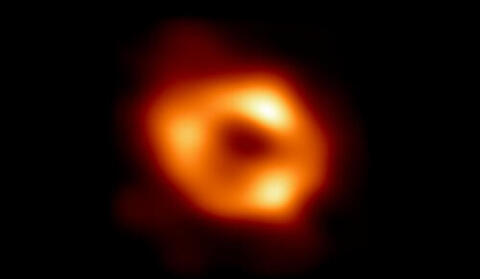Snapping a cosmic selfie — the first image of the Milky Way’s black hole

The Event Horizon Telescope (EHT) Collaboration, an international collaboration aimed at gathering direct images of black holes, has now set its sights close to home.
In a May 12 announcement, EHT researchers presented the first image of Sagittarius A*, the supermassive black hole at the center of the Milky Way, Earth’s home galaxy. The announcement comes three years after EHT made headlines around the world by producing the first photograph of a black hole — M87 in the center of the Virgo A galaxy, located 55 million light years away.
Sagittarius A* — also called Sgr A* — is 27,000 light years from Earth.
A black hole is a part of space that has such intense gravity that nothing, not even light, can escape it. The boundary surface between space and the inside of a black hole is called the “event horizon.”
EHT generates images by linking eight synchronized radio telescopes around the world, including at sites in Chile, Spain, Hawaii, and the South Pole, to create a fundamentally new instrument.
Mislav Baloković, a postdoctoral fellow at the Yale Center for Astronomy and Astrophysics and the Department of Physics, and an EHT member, spoke with Yale News about the new image and what it means for our understanding of our home galaxy.
Why was it important to study the black hole in our own galaxy, as opposed to other galaxies?
Mislav Baloković: The center of our Milky Way galaxy has been an interesting puzzle for over a hundred years, and especially since astronomers discovered about 50 years ago that it shines brightly in radio waves. The Milky Way’s supermassive black hole (SMBH) is the closest one to us and can be studied in greater detail than any other. In comparison with the giant SMBH in the galaxy M87, whose image the EHT published three years ago, Sgr A* is much smaller and situated in a more typical galaxy. This provides us with grounds for comparison. Despite the different mass, size, and environment, they appear remarkably similar. It will certainly be interesting to see if this holds up for other galaxies and their SMBHs, but these are the only two that we know of that the current EHT can study at the event horizon scale.
What does the visual nature of this result bring to the project — both scientifically and in terms of public impact?
Baloković: The visual nature of this effort has always been appealing to me, and the popularity of both M87* and Sgr A* results in the general public shows that this aspect makes our science attractive to a very broad audience. Media professionals estimate that EHT’s image of M87* reached billions of people and is widely recognized. Sgr A* also boasts the status of “our black hole,” just like our star, our planet, our solar system, and our galaxy, which makes it special and I think will contribute to its popularity.
Read full article by Jim Shelton on YaleNews:
